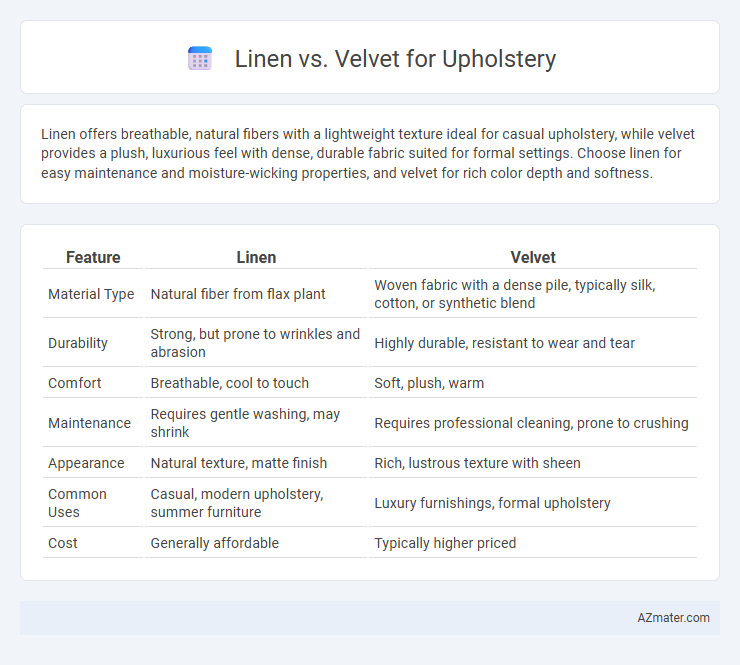Linen offers breathable, natural fibers with a lightweight texture ideal for casual upholstery, while velvet provides a plush, luxurious feel with dense, durable fabric suited for formal settings. Choose linen for easy maintenance and moisture-wicking properties, and velvet for rich color depth and softness.
Table of Comparison
| Feature | Linen | Velvet |
|---|---|---|
| Material Type | Natural fiber from flax plant | Woven fabric with a dense pile, typically silk, cotton, or synthetic blend |
| Durability | Strong, but prone to wrinkles and abrasion | Highly durable, resistant to wear and tear |
| Comfort | Breathable, cool to touch | Soft, plush, warm |
| Maintenance | Requires gentle washing, may shrink | Requires professional cleaning, prone to crushing |
| Appearance | Natural texture, matte finish | Rich, lustrous texture with sheen |
| Common Uses | Casual, modern upholstery, summer furniture | Luxury furnishings, formal upholstery |
| Cost | Generally affordable | Typically higher priced |
Introduction to Linen and Velvet Upholstery
Linen upholstery offers a breathable, natural fabric known for its durability and subtle texture, making it ideal for warm climates and casual, elegant interiors. Velvet upholstery provides a luxurious, soft pile fabric celebrated for its rich texture and vibrant color depth, perfect for creating a plush, sophisticated ambiance. Both materials bring distinct aesthetic and tactile qualities that influence furniture style, maintenance, and overall room atmosphere.
Key Characteristics of Linen Upholstery
Linen upholstery features a natural, breathable fabric derived from flax fibers, known for its durability and moisture-wicking properties. Its smooth texture and matte finish offer a classic, elegant appearance that softens with age while resisting pilling and fading. Linen's hypoallergenic and eco-friendly qualities make it an ideal choice for upholstery in both formal and casual settings.
Key Characteristics of Velvet Upholstery
Velvet upholstery features a dense, plush pile that provides a luxurious texture and rich color depth, making it highly appealing for elegant interiors. Its fibers reflect light differently, offering a soft sheen and enhancing the fabric's dimensionality. Velvet is durable yet requires careful maintenance due to its susceptibility to crushing and staining, demanding specialized cleaning methods to preserve its appearance over time.
Durability: Linen vs Velvet
Velvet upholstery offers superior durability due to its dense weave and resilience against wear, making it ideal for high-traffic areas. Linen, while breathable and comfortable, tends to wear faster and may show signs of aging such as pilling and fading. Choosing velvet enhances longevity in upholstery, while linen suits low-traffic, casual environments.
Comfort and Texture Comparison
Linen upholstery offers a breathable, lightweight texture that feels cool and smooth against the skin, making it ideal for warm climates and providing effortless comfort. Velvet boasts a plush, dense surface with a soft, luxurious pile that adds warmth and a tactile richness to furniture, perfect for cozy, elegant settings. The choice between linen and velvet depends on desired comfort levels and tactile experience, with linen emphasizing cool breathability and velvet delivering deep softness.
Maintenance and Cleaning Requirements
Linen upholstery offers breathability and natural resistance to dirt, making it relatively easy to maintain with regular vacuuming and prompt spot cleaning using mild detergents. Velvet, while luxurious and soft, demands more careful upkeep due to its pile structure, requiring specialized cleaning methods like gentle brushing and professional dry cleaning to prevent crushing or color fading. For longevity, linen's moisture-wicking properties reduce mold risk, whereas velvet's dense fibers can trap dust and allergens, necessitating more frequent deep cleaning.
Style and Aesthetic Appeal
Linen upholstery offers a natural, breathable texture with a light, airy look that complements minimalist and casual decor styles, making it ideal for creating a fresh, elegant atmosphere. Velvet upholstery provides a rich, plush texture with a lustrous sheen that adds depth and luxury, perfect for traditional, glamorous, or contemporary interiors seeking a bold statement. Both fabrics deliver distinct aesthetic appeals: linen emphasizes understated sophistication and comfort, while velvet conveys opulence and visual drama.
Cost Considerations
Linen upholstery typically costs less per yard than velvet, with prices ranging from $30 to $100 compared to velvet's $50 to $200, reflecting fabric durability and production complexity. Linen offers a breathable, natural fiber option that is often more affordable for large-scale projects, while velvet's plush texture and aesthetic appeal come at a premium price due to intricate manufacturing. Budgeting for upholstery requires balancing initial fabric costs with expected lifespan, as linen may require more frequent maintenance but velvet offers longer-lasting luxury and wear resistance.
Best Applications for Each Fabric
Linen is ideal for upholstery in warm climates or casual settings due to its breathability, durability, and natural luster, making it perfect for living room sofas and dining chairs that require a lightweight, easy-care fabric. Velvet, with its luxurious texture, rich depth, and strong durability, suits formal spaces such as elegant lounges or bedroom headboards where a plush, opulent appearance is desired. Both fabrics perform well in moderate-traffic areas, but velvet excels in adding a dramatic, sophisticated look while linen offers a relaxed, airy aesthetic.
Choosing Between Linen and Velvet for Your Home
Linen upholstery offers a breathable, natural texture ideal for warm climates and casual, light-filled interiors, while velvet provides a luxurious, plush feel perfect for adding elegance and warmth to formal living spaces. Consider durability and maintenance: linen is more prone to wrinkles and stains but easily washable, whereas velvet resists wear and provides rich color depth but requires professional cleaning. Your choice depends on lifestyle needs--opt for linen's airy comfort in high-traffic, relaxed rooms and velvet's sophisticated softness where opulence and coziness are priorities.

Infographic: Linen vs Velvet for Upholstery
 azmater.com
azmater.com